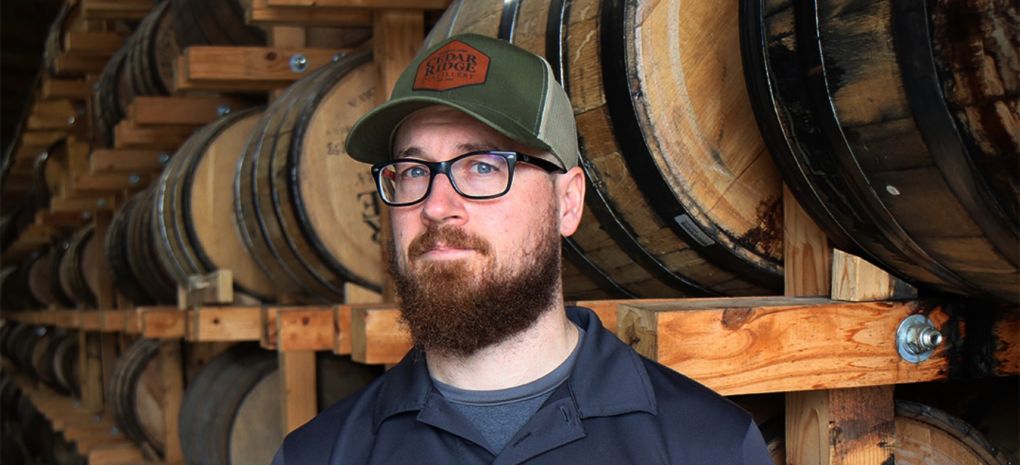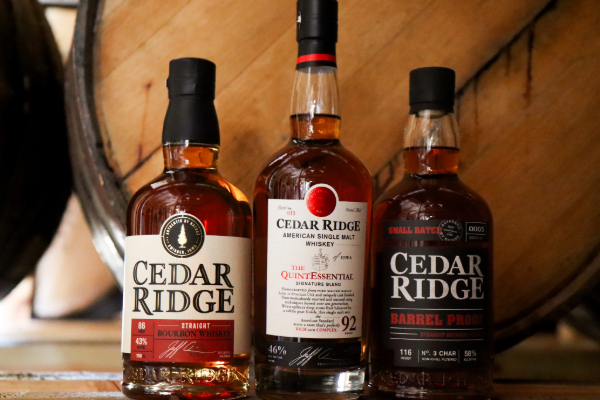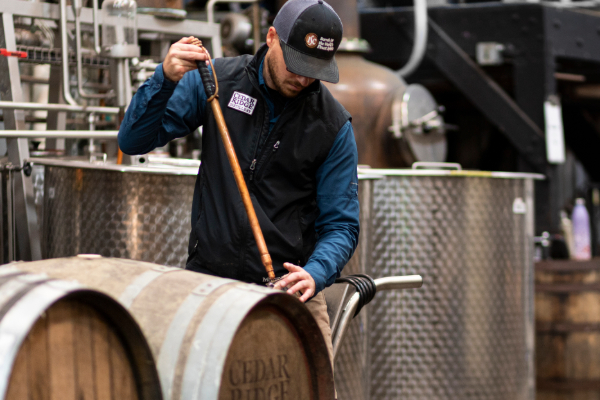
20/01/2025 Explore Cedar Ridge’s Master Distiller, Murphy H. Quint’s insights on the exciting evolution of American single malt whiskey and its potential in the global market
The recent recognition of American single malt whiskey by the Alcohol and Tobacco Tax and Trade Bureau (TTB) has marked a pivotal moment in the spirits industry, and Cedar Ridge’s Master Distiller, Murphy H. Quint, is at the forefront of this transformation. In this interview, Bartender Spirits Awards explores the exciting opportunities and challenges presented by this newly defined category. From fostering innovation to navigating fierce competition with Scotch and Japanese whiskey, Quint offers valuable insights into how distilleries can leverage this shift to grow their brands and educate consumers. Discover how Cedar Ridge is shaping the future of American single malt and what trends are set to define the category’s evolution.
[[relatedPurchasesItems-31]]
With the recent announcement in December recognizing American single malt whiskey, what do you find most exciting about this development, both personally as a Master Distiller at Cedar Ridge and for the industry as a whole?
After years of advocating for the official recognition of American single malt whiskey, an effort driven by the American Single Malt Whiskey Commission and supported by over 10,000 letters to the TTB, it’s incredibly exciting to finally see this initiative come to fruition. We now have a defined category that isn’t just a buzzword but a recognized term with clear guidelines. The definition of American single malt is now simple and straightforward, and we can clearly distinguish it from other whiskey categories. What excites me most is the potential for innovation within this category. With the guidelines in place, the opportunity is now in our hands as distillers to push the boundaries and create something truly remarkable and dynamic in this space.
How do you think the emergence of American single malt whiskey as an official category will impact competition with Scotch and Japanese whiskey?
The competition is certainly fierce, particularly with Scotch and Japanese whiskey, which have long established their global presence. However, American single malt has a distinct advantage in this regard, as our lack of deeply rooted tradition allows for unparalleled innovation. While Scotland has centuries of tradition in production practices, the U.S. can embrace a more experimental approach, exploring new techniques and diverse styles. This freedom to innovate will help American single malt carve out its own unique space in the market. The official recognition of American single malt whiskey is a significant milestone, and it’s sure to inspire more consumers who typically gravitate toward Scotch or Japanese whiskey to explore what American single malt has to offer.

Image: Cedar Ridge American Single Malt Whiskey
How do you plan to leverage the official recognition of the American single malt whiskey category to grow your brand and educate consumers?
Our strategy is to continue releasing exceptional products that justify their $100 price point, ensuring consumers feel confident in their investment. We’ve already experienced success with our award-winning offerings, and while our share of the American single malt market is healthy, it’s still growing. Moving forward, educating consumers about this emerging category and its unique value will be key. Our goal is not only to raise awareness for Cedar Ridge but also to help expand the overall American single malt market, which benefits all distilleries. We’re committed to maintaining high-quality standards, ensuring each product delivers on its promise, and growing the category sustainably.
Also: U.S. Government Officially Recognizes American Single Malt Whiskey as Distinct Category
Touching upon the part of innovation. So, like we know, the TTB has also released a set of requirements that American single malt whiskey needs to have. So, given those requirements, do you see any challenges or any really unique products, you know, chances for product innovations that can be included in American single malt whiskey?
When it comes to challenges, I don’t foresee many. From the outset, the American Single Malt Whiskey Commission aimed to create a category definition that was inclusive of what producers were already doing. Their goal was never to impose overly restrictive rules but to provide a framework that would allow the category to grow while maintaining consistency. The guidelines are both broad enough to foster innovation and specific enough to ensure equal opportunities for all producers. This balance between structure and flexibility presents significant opportunities for innovation. Unlike bourbon or rye, which have more stringent regulations limiting how a distiller or blender can modify the product once it's been barreled, American single malt allows for more creative freedom. We have the option to use both new and used barrels, experiment with different cask finishes, and employ various blending techniques. This flexibility provides us with greater control over the final product and paves the way for exciting innovations in the category.

Image: Cedar Ridge Whiskey Range
So, given the fairly novel nature of the category and the amount of education that will have to go into educating the consumers that this is a new category, what are the trends that you see American single malt whiskey facing, be it in terms of premiumization, sustainability or just a craft product that needs to come into the light for the consumer?
Trends in American single malt whiskey are something I think about a lot, especially given the relatively young nature of the category. We’re navigating uncharted territory, so there’s a lot of uncertainty about where things will go. However, a few trends seem clear to me. First, American single malt producers are likely to focus on producing small quantities of limited-edition releases. These “special releases” will become a hallmark of the category. Instead of churning out thousands of cases of the same product, we’re more likely to see hundreds of cases with unique malts, innovative blends, and experimental cask finishes. This trend is largely driven by the immense saturation in the American whiskey market. There are so many distilleries in the U.S. now, all vying for the same number of consumers as 10 or 20 years ago. To remain competitive, distilleries must become highly strategic. I predict that to stay relevant and attract consumers to try new products, many will continue to release new and distinctive expressions in smaller quantities, keeping their offerings fresh until the market stabilizes.
Also read: The Rise of American Single Malt Whiskey: A New Chapter in Whiskey History
How do casks, mash, and the 100% American production of single malts help consumers differentiate American single malts from Scotch or Japanese whiskey?
The key to helping consumers differentiate American single malt from Scotch or Japanese whiskey lies in the emphasis on American production, unique cask finishes, and the overall production process. American single malts set themselves apart by offering a fresh experience—crafted with 100% American ingredients and often aged in a variety of distinctive casks, such as new oak or special finishes, that bring bold and diverse flavor profiles. The challenge is getting consumers to take that first step and make the purchase. Once they feel confident in the value of their initial investment, they’re more likely to return to the category and explore the distinct characteristics of American single malt. This sets the foundation for building long-term loyalty, as consumers begin to appreciate the innovation and creativity within this new and exciting category.

Image: Cedar Ridge’s Master Distiller Murphy H. Quint
How can distilleries help push their American single malt whiskey to first-time consumers, especially when competing with established whiskeys like Scotch or Japanese whiskey?
Distilleries can employ a multi-faceted approach to help retailers and distributors push American single malt whiskey to first-time consumers, especially when competing with well-established brands like Scotch and Japanese whiskey. With retailers, the key is to provide hands-on training and education. Even for smaller distilleries with limited travel budgets, it’s essential to strategically distribute in markets where they can actively support retailers through in-store tastings and product education. This ensures retailers understand the value of American single malt and can confidently communicate that to customers, making it easier to drive initial sales. When it comes to distributors, the challenge lies in industry consolidation. Distributors manage extensive portfolios, making it hard for new products to stand out. Distilleries must find ways to convince distributors to prioritize American single malt by showcasing its unique qualities and market potential. Building strong distributor relationships, combined with consistent quality and consumer demand, will help ensure the product is effectively introduced to the market and gains traction.
What are Cedar Ridge's plans for the future in terms of educating consumers about American single malt whiskey, and are there any upcoming projects you'd like to share?
At Cedar Ridge, we’ve built recognition with our "Quintessential" single malt, which has earned significant acclaim in the market. Our special releases, which we launch twice annually, have also contributed to our growing reputation. Moving forward, our strategy is focused on maintaining quality while gradually increasing the batch sizes for these special releases. This method allows us to expand distribution at a measured pace, reaching more consumers without compromising the integrity of the product. We’re intentionally avoiding the rush to scale quickly, recognizing that rapid expansion could overwhelm distributors and retailers. Instead, we’re focusing on careful, sustainable growth that helps us build a loyal consumer base. As we move forward, educating consumers about the value of American single malt remains a key priority, and we’re committed to strengthening our position in the market through quality and thoughtful expansion.
Header image sourced from Cedar Ridge
Related Links
Five Icons of Whiskey in the USA today
Bottoms up: 9 companies redefining Whiskey in the US
2025 Registrations are now closed


